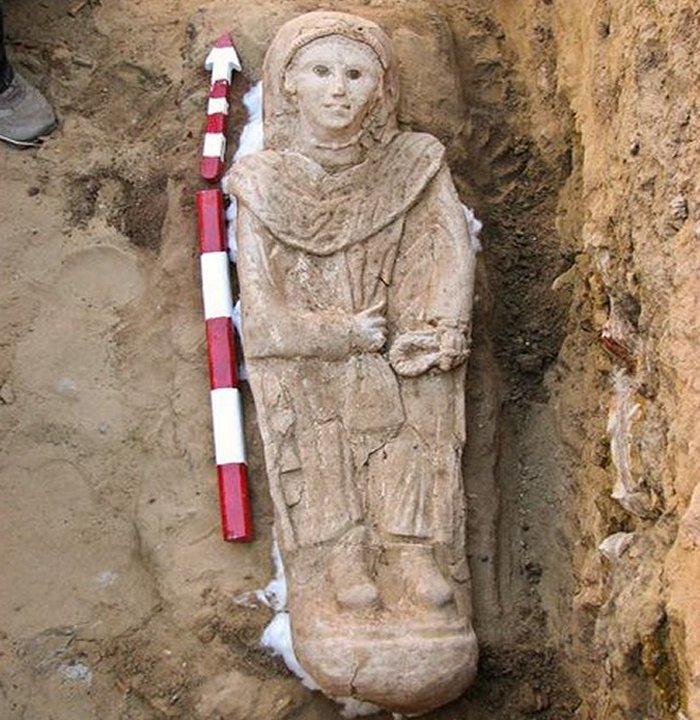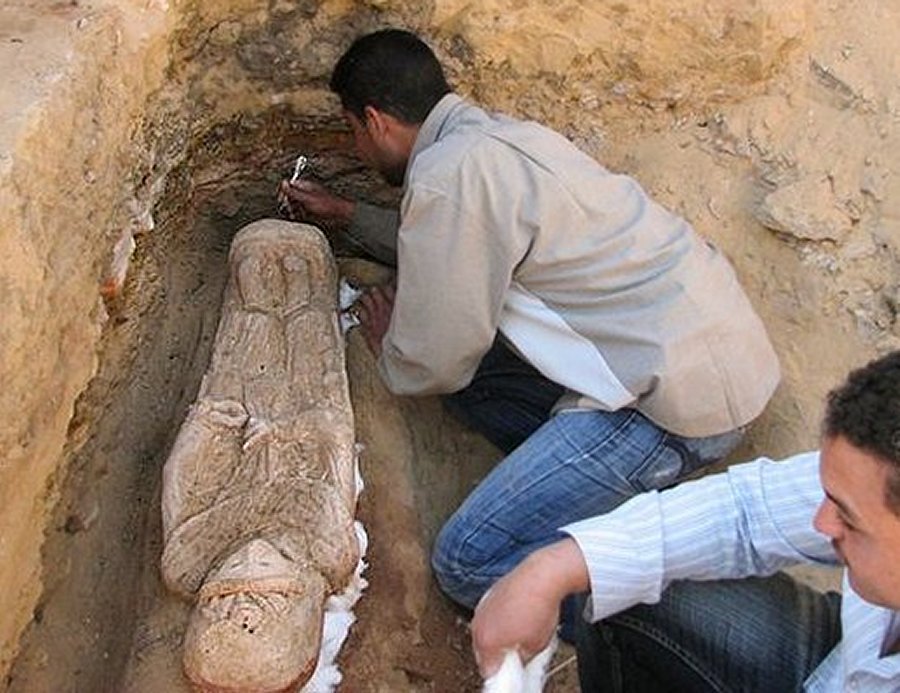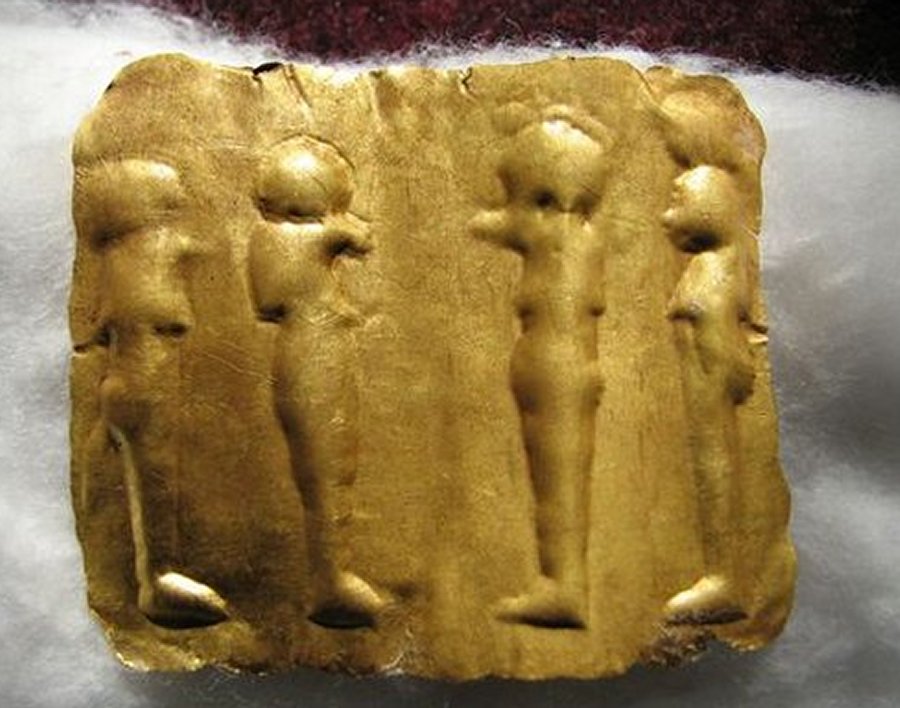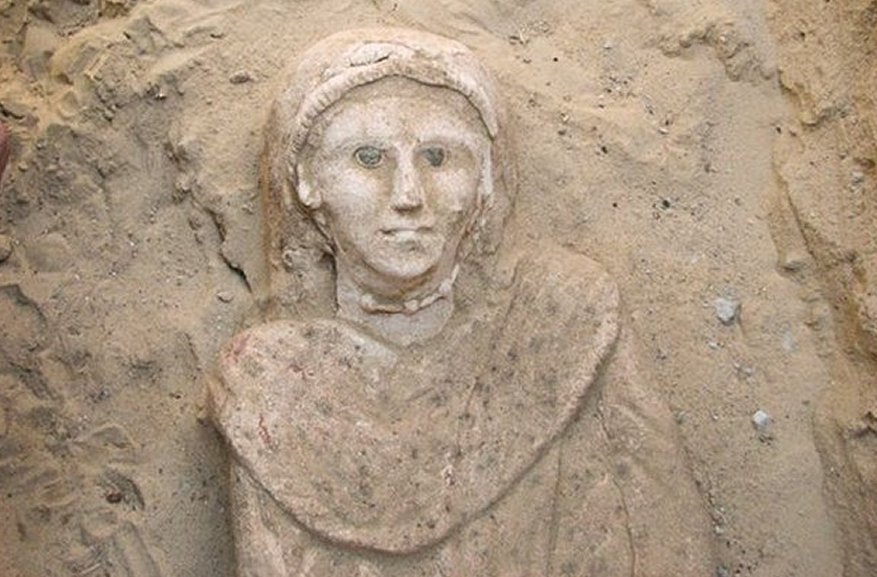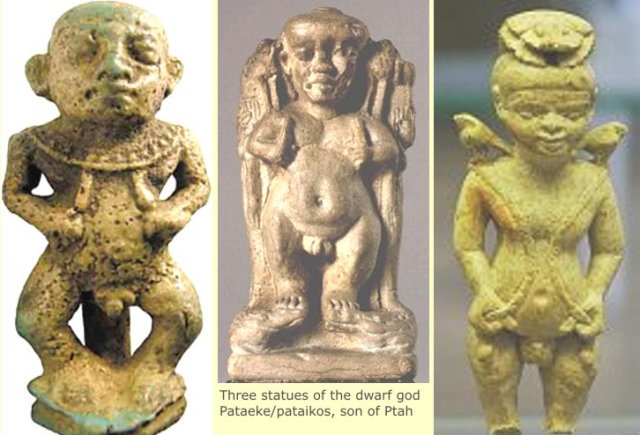Curious Golden Figurine Of Female Dwarf Is A Puzzle
AncientPages.com - Egypt is a land full of ancient mysteries and one of them is an astonishing discovery made by archaeologists a while ago.
How and why did this mysterious mini-woman end up in an ancient Egyptian tomb? Was she a woman of high power and influence?
Did she play an important role in the ancient Egyptian society?
Who was she? Image credit: Egyptian Supreme Council of Antiquities
The mummy, measuring just 3.2 feet (97 centimeters) dates back to the Roman era. She was discovered in a 2,000-year-old tomb in the Bahariya Oasis, about 225 miles southwest of Cairo. Covered in intricately molded plaster, the woman was wearing a tunic, headscarf, necklace, bracelet and shoes.
See also:
Bes – Ancient Egyptian Dwarf God Of Childbirth, Humor, Song and Dance
Makhunik – 5,000-Year-Old City Of The Dwarfs
Obscure History Of Skara Brae – Home To Dwarfs
She was dressed in Roman robes and scientists think that the burial style indicates she belonged to Egypt's long period of Roman rule, from 31 BC until the Arab invasions of the 7th century.
Archaeologists carefully tease the tiny Greco-Roman sarcophagus from its rock-hewn tomb in the Bayariya Oasis, Egypt. Image credit: Egyptian Supreme Council of Antiquities
The site contains at least 14 tombs from the era when ancient Rome controlled Egypt, from 30 BC to AD 395. Jewelry, funerary masks, and pottery were also found, though the sand-covered tombs have been damaged by humidity and seeping groundwater.
An additional and important discovery are golden relics depicting the four sons of the Egyptian god Horus.
Embossed on a sheet of gold from the newfound Greco-Roman tombs in Egypt, the four sons of Horus-ancient Egypt's god of the sky-were believed to protect the intestines, lungs, stomach, and liver. Image credit: Egyptian Supreme Council of Antiquities
Appropriately, the brothers-Qebehsenuef, Hapi, Duamutef, and Imsety-often decorated jars holding mummies' organs.
The identity of the woman remains a mystery. At first scientists thought she could have been a child, but considering the amount of hard work making the coffin as beautiful as possible, it seemed unlikely. It is more probably she was a woman of high power and influence.
Perhaps she was a dwarf. Short stature didn't prevent dwarves in ancient Egyptian culture from attaining high positions in society. Some served as assistants to the pharaoh, while others were looked up to as gods.
This mummy is covered by layers of plaster," turning the deceased into something of a human statue. Image credit: Egyptian Supreme Council of Antiquities
The remains of dwarfs are abundant and include complete and partial skeletons. Dwarfs were employed as personal attendants, animal tenders, jewelers, and entertainers. Several high-ranking dwarfs especially from the Old Kingdom (2700-2190 BC) achieved important status and had lavish burial places close to the pyramids.
Their costly tombs in the royal cemeteries and the inscriptions on their statutes indicate their high-ranking position in Egyptian society and their close relation to the king. Some of them were Seneb, Pereniankh, Khnumhotpe, and Djeder.
There were at least two dwarf gods, Ptah and Bes. The god Ptah was associated with regeneration and rejuvenation.
The god Bes was a protector of sexuality, childbirth, women, and children. He was a favored deity particularly during the Greco-Roman period. His temple was recently excavated in the Baharia oasis in the middle of Egypt.
The burial sites and artistic sources provide glimpses of the positions of dwarfs in daily life in ancient Egypt. Dwarfs were accepted in ancient Egypt; their recorded daily activities suggest assimilation into daily life, and their disorder was not shown as a physical handicap.
Wisdom writings and moral teachings in ancient Egypt commanded respect for dwarfs and other individuals with disabilities," writes Chahira Kozma in the science paper "Dwarfs in ancient Egypt".
We may never know the true identity of the mini-woman discovered in the mysterious tomb.
AncientPages.com
Expand for referencessource: SCA
More From Ancient Pages
-
 Startling Evidence Modern Humans Lived In The Mandrin Cave 56,800 Years Ago Where They Met The Neanderthals
Archaeology | Mar 12, 2022
Startling Evidence Modern Humans Lived In The Mandrin Cave 56,800 Years Ago Where They Met The Neanderthals
Archaeology | Mar 12, 2022 -
 Anundshög Burial Mound: One Of Sweden’s Richest And Largest Sacred Ancient Sites
Featured Stories | Aug 29, 2018
Anundshög Burial Mound: One Of Sweden’s Richest And Largest Sacred Ancient Sites
Featured Stories | Aug 29, 2018 -
 Genes For Learning And Memory Are 650 Million Years Old – Study Shows
Evolution | Jul 19, 2023
Genes For Learning And Memory Are 650 Million Years Old – Study Shows
Evolution | Jul 19, 2023 -
 Never Before Seen 3D Images Of Noah’s Ark Finally Revealed To The Public
Archaeology | Nov 17, 2019
Never Before Seen 3D Images Of Noah’s Ark Finally Revealed To The Public
Archaeology | Nov 17, 2019 -
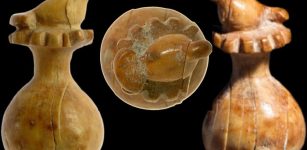 The Dove And The Pomegranate: Who Was The High-Ranking Lady Who Owned This Unique Artifact In The First Temple Period?
Artifacts | Aug 9, 2023
The Dove And The Pomegranate: Who Was The High-Ranking Lady Who Owned This Unique Artifact In The First Temple Period?
Artifacts | Aug 9, 2023 -
 Huldra: Seductive Female Creature Living In Forest Or Mountains In Norse Beliefs
Featured Stories | Feb 8, 2018
Huldra: Seductive Female Creature Living In Forest Or Mountains In Norse Beliefs
Featured Stories | Feb 8, 2018 -
 World’s Oldest Domesticated Fava Beans Were Grown In The Galilee Millennia Ago
Archaeology | Nov 28, 2015
World’s Oldest Domesticated Fava Beans Were Grown In The Galilee Millennia Ago
Archaeology | Nov 28, 2015 -
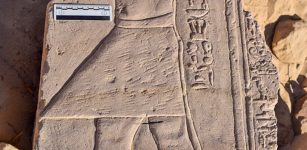 2nd Century Roman Temple Unearthed In Aswan, Egypt
Archaeology | Feb 23, 2018
2nd Century Roman Temple Unearthed In Aswan, Egypt
Archaeology | Feb 23, 2018 -
 The Ancient Giants Who Ruled America: The Missing Skeletons And The Great Smithsonian Cover-Up
Biblical Mysteries | Apr 26, 2014
The Ancient Giants Who Ruled America: The Missing Skeletons And The Great Smithsonian Cover-Up
Biblical Mysteries | Apr 26, 2014 -
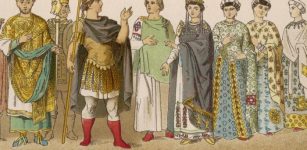 Justinianic Plague: Modeling Study Challenges Death Rate And Severity Of Infectious Disease
Archaeology | May 4, 2020
Justinianic Plague: Modeling Study Challenges Death Rate And Severity Of Infectious Disease
Archaeology | May 4, 2020 -
 Secret Underground Ancient Teotihuacan Tunnel May Solve A Long-Standing Mystery And Reveal Royal Tombs
Civilizations | Jul 8, 2016
Secret Underground Ancient Teotihuacan Tunnel May Solve A Long-Standing Mystery And Reveal Royal Tombs
Civilizations | Jul 8, 2016 -
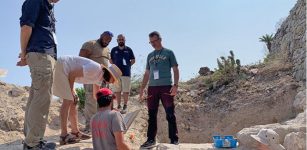 2,000-Year-Old Roman House Discovered In Malta
Archaeology | Jul 27, 2023
2,000-Year-Old Roman House Discovered In Malta
Archaeology | Jul 27, 2023 -
 Surprise! ‘Viking Ship’ Found On The Seabed Is Not What We Previously Thought And Rewrites Scandinavian Maritime History, Scientists Say
Archaeology | Mar 10, 2025
Surprise! ‘Viking Ship’ Found On The Seabed Is Not What We Previously Thought And Rewrites Scandinavian Maritime History, Scientists Say
Archaeology | Mar 10, 2025 -
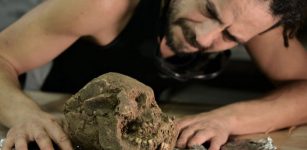 Lady SAS – Ancient Skeleton Of Foreign Woman Found In Palenque – Who Was She?
Archaeology | Apr 11, 2023
Lady SAS – Ancient Skeleton Of Foreign Woman Found In Palenque – Who Was She?
Archaeology | Apr 11, 2023 -
 3,800-Year-Old Wall Relief Created By Ancient Caral People Unearthed In Peru
Archaeology | Aug 28, 2018
3,800-Year-Old Wall Relief Created By Ancient Caral People Unearthed In Peru
Archaeology | Aug 28, 2018 -
 The Curse Fell On King Midas And His Gold Desire Became A Nightmare
Featured Stories | Feb 6, 2025
The Curse Fell On King Midas And His Gold Desire Became A Nightmare
Featured Stories | Feb 6, 2025 -
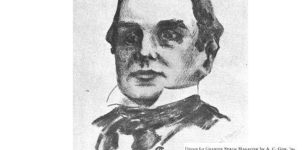 On This Day In History: Samuel Morey Patents The Internal Combustion Engine – On April 1, 1826
News | Apr 1, 2017
On This Day In History: Samuel Morey Patents The Internal Combustion Engine – On April 1, 1826
News | Apr 1, 2017 -
 Why Did Ancient Humans Have Same Sense Of Smell, But Different Sensitivities?
Archaeology | Jan 6, 2023
Why Did Ancient Humans Have Same Sense Of Smell, But Different Sensitivities?
Archaeology | Jan 6, 2023 -
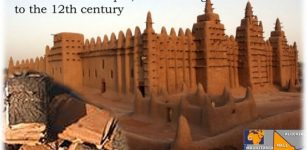 Ancient Manuscripts Of Mythical City Of Timbuktu
Artifacts | Jun 12, 2014
Ancient Manuscripts Of Mythical City Of Timbuktu
Artifacts | Jun 12, 2014 -
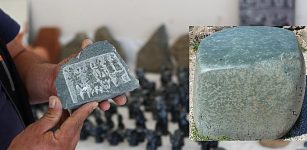 Famous Ancient Hittite Figures And Symbols Engraved In Stone By A Local Artist From Çorum Province, Anatolia
News | Aug 8, 2020
Famous Ancient Hittite Figures And Symbols Engraved In Stone By A Local Artist From Çorum Province, Anatolia
News | Aug 8, 2020

